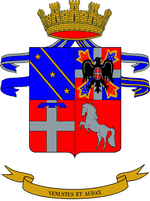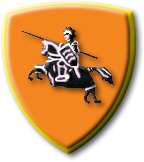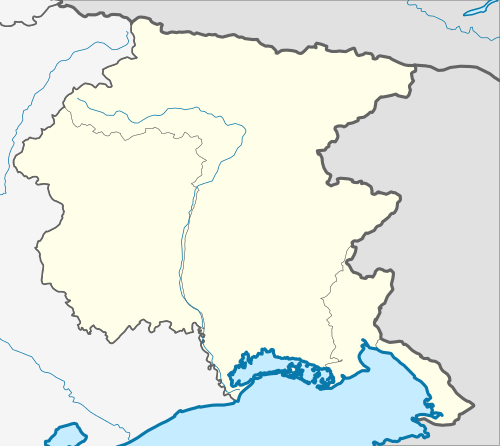Pozzuolo del Friuli Cavalry Brigade
| Brigata di Cavalleria "Pozzuolo del Friuli" | |
|---|---|
|
Coat of Arms Pozzuolo del Friuli Cavalry Brigade | |
| Active | 1835 - present |
| Country | Italy |
| Allegiance | Italian Army |
| Branch | Army |
| Type | Brigade |
| Role | Cavalry |
| Part of | Friuli Division Command |
| Garrison/HQ | Bologna |
| Colors | orange |
| Engagements |
World War I World War II Bosnia SFOR Kosovo KFOR Afghanistan ISAF Iraq Multinational force in Iraq |
| Commanders | |
| Current commander | Brigadier Flaviano Godio |
The Pozzuolo del Friuli Cavalry Brigade is an amphibious and air-assault brigade of the Italian Army, based mainly in the north-east of the country. The brigade was a wheeled armoured brigade under the 1st Defence Forces Command until it was merged with the Friuli Air Assault Brigade in early 2014.
History
Constitution
The origins of the Pozzuolo del Friuli Cavalry Brigade date back to 7 March 1835 when in the Kingdom of Sardinia the Cuirassier regiments "Piemonte Reale" and "Genova" and the Lancer regiment "Aosta" were combined to from the II Cavalry Brigade. On 4 October 1836 the "Genoa" and "Aosta" were replaced by the Lancers regiment "Novara".
The brigade did not participate in the First Italian War of Independence in 1848 as its regiments were attached to infantry divisions. After the war the II Cavalry Brigade was disbanded.
The brigade was quickly activated again on the eve of the Second Italian War of Independence in 1859. This time the II Cuirassier Brigade consisted of the Cuirassier regiments "Savoia Cavalleria" and "Genova Cavalleria". Together with the I Cuirassier Brigade (Cuirassier regiments "Nizza Cavalleria" and "Piemonte Reale Cavalleria") the brigade formed the armys sole cavalry division. After the war the brigade was garrisoned in Milan with its regiments in Turin and Vigevano near Milan. In 1863 the brigade was once more disbanded.
However again on the eve of war, this time the Third Italian War of Independence in 1866 the brigade was once more activated with its Cuirassier regiments "Savoia Cavalleria" and "Genova Cavalleria" and formed with the I Cuirassier Brigade (Cuirassier regiments "Nizza Cavalleria" and "Piemonte Reale Cavalleria") the armys sole cavalry division. After the war the fate of the brigade was in balance once again until the government issued a decree 4 December 1870 to establish permanent cavalry brigades.
World War I

At the outbreak of World War I the brigade consisted of the 4th Cavalry Regiment Genova Cavalleria and the 5th Cavalry Regiment Lancieri di Novara. The brigade fell under the 1st Cavalry Division and was based in the region of Friuli. During the war the brigade served on the Italian Front as mounted infantry or infantry as needed. In 1917 the brigade covered the flight of the remnants of the Italian 3rd Army after the disastrous Battle of Caporetto. With Central Power troops advancing rapidly towards the Venetian plains the 3rd Army was in danger of being encircled. Therefore, the II Cavalry Brigade under general Emo Capodilista and the Bergamo Infantry Brigade under colonel Piero Balbi were sent to Pozzuolo del Friuli and tasked with delaying the enemy long enough for the 3rd Army to cross the Tagliamento river.
While the cavalry units arrived in Pozzuolo del Friuli in the late afternoon of 29 October the Bergamo arrived after a forced march at noon of 30 October 1917. The two brigade commanders decided that one Bergamo battalion would defend Pozzuolo, while the Lancieri di Novara would cover the right and the Genova Cavalleria the left flank of the village. The remaining battalions of the Bergamo were sent to the north-west to block the road to Codroipo. A roll call on the morning of the 30 October showed that the cavalry brigade was only 968 men strong.
All morning patrols of the cavalry regiments had encountered advance parties of the German 117th Infantry Division and by 14h the two brigades were under full attack by three enemy divisions: the Bergamo units were attacked by the German 5th Infantry Division, while the Genova Cavalleria was attacked by the German 117th Infantry and the Austrian-Hungarian 60th Infantry Division. With the Genova Cavalleria under heavy attack the Lancers of the Lancieri di Novara began harass the left flank of the enemy in repeated cavalry charges.
By 17:30 the cavalry brigade had suffered almost 400 dead and the enemy had entered the village of Pozzuolo. Around 18h general Capodilista ordered his troops to disengage and retreat. Colonel Balbi and the headquarters of the Bergamo along with one of its battalions remained in Pozzuolo to cover the retreat. Fifteen minutes later the remnants of the cavalry brigade rode in formation south towards Santa Maria di Sclaunicco. The last unit to leave Pozzuolo was the 4th Squadron of the Genova Cavalleria regiment, which executed a last charge against the enemy to cover the road to Santa Maria di Sclaunicco. By nightfall the brigade had lost 467 of its 968 men, while the Bergamo brigade was almost completely destroyed.
After the army had retreated behind the Piave river the brigade was brought back to full strength and fought in the final battles of the war on the Italian front: the Battle of the Piave River in June 1918 and the Battle of Vittorio Veneto in October 1918.
World War II
In 1926 the brigade was renamed as II Higher Cavalry Command and commanded four Lancer regiments: "Lancieri di Novara", "Lancieri di Aosta", "Lancieri di Milano" and "Lancieri Vittorio Emanuele II". In June 1930 the three Higher Cavalry Commands were renamed as Cavalry Brigades. In 1935 the II Cavalry Brigade was motorized and became the II Fast Brigade, which was later changed to II Fast Brigade Emanuele Filiberto Testa di Ferro. On 1 February 1938 the brigade command was disbanded and its units entered the newly raised 2nd Cavalry Division Emanuele Filiberto Testa di Ferro.
The division participated in the Axis Invasion of Yugoslavia and remained afterwards in Yugoslavia as garrison unit. In May 1942, the division was selected to convert to an Armoured division and started converting to the 134 Armoured Division Freccia; however, the conversion was cancelled and it returned to the Cavalry division format. In December 1942, the division moved to France as part of the Italian occupying forces where it was based in Toulon. The division remained in France until the Italian surrender, when it returned to Italy in September 1943, where it disbanded.
Cold War
On 1 January 1953 the Italian Army activated in Rome the Pozzuolo del Friuli Armored Division as its third armored division. The division consisted of the 4th Tank Regiment (three battalions with M26 Pershing tanks), 1st Bersaglieri Regiment (three battalions with M3 Half-tracks), the 1st Armored Artillery Regiment (four artillery groups with M7 Priests and one anti-air artilelry group) and the I Engineer Battalion. In 1954 the division received the Lancieri di Firenze Armored Cavalry Squadron on M8 Greyhound, which was expanded to full squadrons group by 1956.
In 1957 the army decided to concentrate its forces in the North-Eastern region of Friuli near the Yugoslav border and subsequently it was decided to disband the armored division in Rome and instead raise armored brigades in Friuli. The first step of this re-alignment occurred on 1 April 1957 with the activation of the Cavalry Brigade in Gradisca d'Isonzo with he armored cavalry regiments Piemonte Cavalleria (2nd), Genova Cavalleria (4th) and Lancieri di Novara (5th) and the 8th Self-propelled Field Artillery Regiment. The brigade fell under the V Army Corps tasked with defending North-Eastern Italy against a possible attack by either Yugoslav or Warsaw Pact forces. As next steps the army transferred the 4th Tank Regiment to the Legnano Division on 1 May 1958 and the 1st Bersaglieri Regiment to the Granatieri di Sardegna Division on 1 December 1958. The 1st Armored Artillery Regiment four groups were transferred to four other artillery regiments and on 31 December 1958 the regiment itself, the Lancieri di Firenze Armored Cavalry Squadron and the Pozzuolo del Friuli Armored Division were disbanded.
On 1 January 1959 the Cavalry Brigade in Gradisca d'Isonzo changed its name to Pozzuolo del Friuli Cavalry Brigade and received the colours, symbols and traditions of the dissolved armored division. The brigade was organized as a mechanized brigade with one tank battalion, two mechanized cavalry regiments and a self-propelled artillery regiment. In 1975 the Italian Army undertook a major reform and also the Pozzuolo del Friuli saw its composition change. The brigade became an armored brigade under the Mantova Mechanized Division and its units were used to raise a second armored cavalry brigade - the Vittorio Veneto Armored Brigade in Villa Opicina. On 1 October 1975 the brigade had concluded its conversion to armored brigade and consisted of the following units.
- Pozzuolo del Friuli Armored Brigade in Palmanova
- Pozzuolo del Friuli Command and Signal Battalion, in Palmanova
-
 4th Mechanized Squadrons Group Genova Cavalleria, in Palmanova, (VCC-2 Armoured personnel carriers)
4th Mechanized Squadrons Group Genova Cavalleria, in Palmanova, (VCC-2 Armoured personnel carriers) -
 5th Tank Squadrons Group Lancieri di Novara, in Codroipo, (Leopard 1A2 Main battle tanks)
5th Tank Squadrons Group Lancieri di Novara, in Codroipo, (Leopard 1A2 Main battle tanks) -
 28th Tank Squadrons Group Cavalleggeri di Treviso, in Palmanova, (Leopard 1A2 Main battle tanks)
28th Tank Squadrons Group Cavalleggeri di Treviso, in Palmanova, (Leopard 1A2 Main battle tanks) -
 120th Self-propelled Field Artillery Group Po, in Palmanova, (M109 Self-propelled howitzers)
120th Self-propelled Field Artillery Group Po, in Palmanova, (M109 Self-propelled howitzers) -
 Pozzuolo del Friuli Logistic Battalion, in Visco
Pozzuolo del Friuli Logistic Battalion, in Visco - Pozzuolo del Friuli Anti-tank Squadron, in Palmanova
- Pozzuolo del Friuli Engineer Company, in Palmanova
In 1986 the Italian Army abolished the divisional level and the Pozzuolo del Friuli came under direct command of the 5th Army Corps. Additionally the brigade received the 7th Reconnaissance Squadrons Group Lancieri di Milano from the disbanded Mantova Division. In 1989 with the end of the Cold War the army began to draw down its forces and the 7th Lancieri di Milano was disbanded on 11 December 1989, followed by the 28th Cavalleggeri di Treviso on 31 March 1991.
In 1991 the brigade returned to use the name Pozzuolo del Friuli Cavalry Brigade after it had replaced its Leopard 1A2 tanks and VCC-2 armored personnel carries with wheeled Centauro tank destroyers. During the same year the Italian Army disbanded seven of its combat brigades and numerous smaller units. One of the disbanded brigades was the Vittorio Veneto Armored Brigade and two of its units were transferred to the Pozzuolo del Friuli. Furthermore, the remaining battalions, groups and squadrons groups of the army were allowed to return to use their traditional regimental names and therefore the Pozzuolo del Friuli changed its composition radically in 1991. By the end of the year the brigade consisted of the following units:
- Pozzuolo del Friuli Cavalry Brigade in Palmanova
- Pozzuolo del Friuli Command and Tactical Support Battalion, in Palmanova
-
 2nd Cavalry Regiment Piemonte Cavalleria, in Villa Opicina
2nd Cavalry Regiment Piemonte Cavalleria, in Villa Opicina -
 4th Cavalry Regiment Genova Cavalleria, in Palmanova
4th Cavalry Regiment Genova Cavalleria, in Palmanova -
 5th Cavalry Regiment Lancieri di Novara, in Codroipo
5th Cavalry Regiment Lancieri di Novara, in Codroipo -
 84th Infantry (Training) Battalion Venezia, in Falconara Marittima
84th Infantry (Training) Battalion Venezia, in Falconara Marittima -
 8th Self-propelled Field Artillery Regiment Pasubio, in Banne
8th Self-propelled Field Artillery Regiment Pasubio, in Banne -
 Pozzuolo del Friuli Logistic Battalion, in Visco
Pozzuolo del Friuli Logistic Battalion, in Visco
The 28th Tank Squadrons Group Cavalleggeri di Treviso and the 120th Self-propelled Field Artillery Group Po were disbanded.
After the Cold War
In January 1997 the brigade lost the 84th Infantry (Training) Battalion Venezia and on 1 December 2000 the brigade received the Lagunari Regiment Serenissima in Venice from the disbanding Projection Forces Command. In September 2001 the brigade disbanded the 8th Self-propelled Field Artillery Regiment, which name was given to 11th Self-propelled Field Artillery Regiment Teramo of the Garibaldi Bersaglieri Brigade on 1 October 2001. As replacement the brigade received the 52nd Self-propelled Artillery Regiment Torino, in Vercelli from the disbanding Centauro Armoured Brigade. The same year the brigade was joined by the 3rd Engineer Regiment in Udine. In 2005 the 52nd Self-propelled Artillery Regiment with its heavy tracked M109 howitzers was replaced by the Horse Artillery Regiment Volòire in Milan which fielded lighter FH-70 towed howitzers.
2013 reform
In 2013 the army decided to reduce its strength by two brigades. At first the Pozzuolo del Friuli was scheduled to disband in fall of 2013, but the Army decided to pass the name of the Pozzuolo del Friuli brigade to the Friuli Air Assault Brigade, which in turn ceded its name and traditions on 16 July 2013 to the Friuli Division Command in Florence. After the brigades units had passed to other brigades during summer 2013, the Pozzuolo del Friuli Cavalry Brigade brigade staff and command battalion were disbanded in fall of 2013. In the years before the reform the brigade consisted of the following units.
-
 Pozzuolo del Friuli Combat Service Support Battalion in Gorizia was disbanded
Pozzuolo del Friuli Combat Service Support Battalion in Gorizia was disbanded -
 2nd Cavalry Regiment Piemonte Cavalleria in Trieste passed to the Julia Alpine Brigade
2nd Cavalry Regiment Piemonte Cavalleria in Trieste passed to the Julia Alpine Brigade -
 4th Cavalry Regiment Genova Cavalleria in Palmanova passed to the Friuli Air-assault brigade
4th Cavalry Regiment Genova Cavalleria in Palmanova passed to the Friuli Air-assault brigade -
 5th Cavalry Regiment Lancieri di Novara in Codroipo passed to the Ariete Armoured Brigade
5th Cavalry Regiment Lancieri di Novara in Codroipo passed to the Ariete Armoured Brigade -
 Lagunari Regiment Serenissima in Venice passed to the Friuli Air-assault brigade
Lagunari Regiment Serenissima in Venice passed to the Friuli Air-assault brigade -
 Horse Artillery Regiment Volòire in Milan passed to the Friuli Air-assault brigade
Horse Artillery Regiment Volòire in Milan passed to the Friuli Air-assault brigade -
 3rd Engineer Regiment in Udine passed to the Friuli Air-assault brigade
3rd Engineer Regiment in Udine passed to the Friuli Air-assault brigade
Today
With the 2013 reform the Pozzuolo del Friuli Brigade added amphibious and air-assault capabilities. It is nowadays the largest brigade of the Italian Army. Since the official transfer of the name and traditions of the Pozzuolo del Friuli Cavalry Brigade to its new brigade staff and command battalion in Bologna in January 2014, the brigade is composed of the following units.
-
 Pozzuolo del Friuli Command and Tactical Support Battalion in Bologna (Emilia-Romagna)
Pozzuolo del Friuli Command and Tactical Support Battalion in Bologna (Emilia-Romagna) -
 4th Cavalry Regiment Genova Cavalleria in Palmanova (Friuli-Venezia Giulia)
4th Cavalry Regiment Genova Cavalleria in Palmanova (Friuli-Venezia Giulia) -
 66th Air Assault Infantry Regiment Trieste in Forlì (Emilia-Romagna)
66th Air Assault Infantry Regiment Trieste in Forlì (Emilia-Romagna) -
 Lagunari Amphibious Assault Infantry Regiment "Serenissima" in Venice (Veneto)
Lagunari Amphibious Assault Infantry Regiment "Serenissima" in Venice (Veneto) -
 5th Army Aviation Regiment Rigel in Casarsa della Delizia (Friuli-Venezia Giulia)
5th Army Aviation Regiment Rigel in Casarsa della Delizia (Friuli-Venezia Giulia) -
 7th Army Aviation Regiment Vega in Rimini (Romagna)
7th Army Aviation Regiment Vega in Rimini (Romagna) -
 Horse Artillery Regiment "Volòire" in Milan (Lombardy)
Horse Artillery Regiment "Volòire" in Milan (Lombardy) -
 3rd Engineer Regiment in Udine (Friuli-Venezia Giulia)
3rd Engineer Regiment in Udine (Friuli-Venezia Giulia) -
 Pozzuolo del Friuli Logistic Regiment in Budrio (Romagna)
Pozzuolo del Friuli Logistic Regiment in Budrio (Romagna)
All regiments are battalion sized.
Equipment
The Genova Cavalleria regiment is equipped with a mix of Centauro tank destroyers and Puma 4x4 wheeled armored personnel carriers. The Trieste infantry regiment is equipped with Puma 6x6 armored personnel carriers. The regiments mortar company is equipped with 120mm mortars, while the anti-tank company fields Spike anti-tank guided missile systems. The Lagunari regiment is equipped with AAV7-A1 amphibious assault vehicles and Puma 4x4; the regiments mortar company and anti-tank company are identical to the mortar and anti-tank company of the Trieste. The Rigel aviation regiment fields on squadron group with three A129 Mangusta attack helicopter squadrons and one squadron group with two NH90 transport helicopter and one A109A EOA reconnaissance helicopter squadrons. The Vega aviation regiment fields three squadron groups: two with three NH90 transport helicopter squadrons each and one with three A129D attack helicopter squadrons. The artillery regiment of the brigade fields 18x FH-70 towed howitzers.
Sources
- Italian Army Homepage: Pozzuolo del Friuli Cavalry Brigade history
- Italian Army Homepage: Pozzuolo del Friuli Armoured Division history

